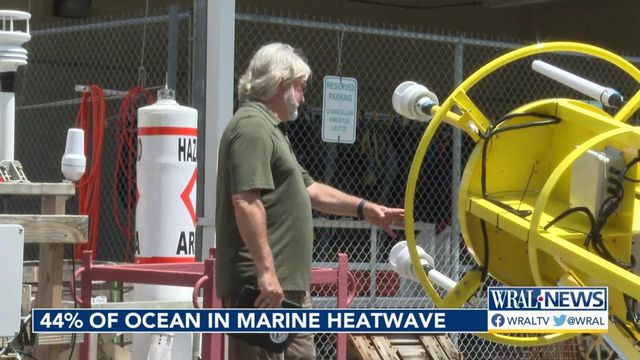'It feels like a hot tub': Unprecedented marine heatwaves are cooking oceans across the globe
Sandy Smith came to Wrightsville Beach after a disappointing trip to south Florida, where water temperatures reached triple digits this week.
"You get into the ocean to feel refreshed,” she said. “But it feels like a hot tub."
Ocean temperatures across the globe have been hitting unprecedented highs this summer. Scientists say the worst is yet to come.

DIllion Amaya, a research physical scientist at the National Oceanic and Atmospheric Administration, says marine heatwaves are affecting about 44% of the world's oceans. NOAA expects that to rise to 50% by September.
"We've never seen this large of an area throughout the globe be considered under extreme warming like this," Amaya said.
A marine heatwave occurs when ocean temperatures are above the 90th percentile for longer than five days. NOAA mostly measures surface temperatures via satellite.
"There is a developing marine heatwave along the Gulf Stream, particularly in the waters off of North Carolina,” Amaya said. “And our models suggest that that could intensify and potentially stick around until the fall."
Scientists pay close attention to marine heat waves because water is crucial for the planet’s ability to store heat. The earth’s oceans have absorbed about 90% of the heat trapped by greenhouse gas emissions over the past 50 years.
"It's pretty unequivocal that the extreme temperatures that we're seeing here are made warmer because of climate change," Amaya said.
UNC-Wilmington's Coastal Ocean Research and Monitoring Program has buoys off the North Carolina coast that track data including water temperature. Sensors around the Wilmington area were reading water temperatures between 84 and 88 degrees Fahrenheit on Friday.
"The warm water is being pushed farther than it's ever been pushed before," said Doug Gamble, a climatology professor at UNCW. He and other researchers are starting to analyze warming trends after collecting more than 20 years of data.
In addition to background warming from human-caused climate change, El Niño conditions this year may compound the impact.
El Niño is a natural climate cycle that typically increases average air and sea temperatures and can have an impact on severe weather.
Sea surface temperatures may continue to climb and break records in the coming months.
Gamble, Amaya, and other scientists are concerned that warmer ocean temperatures could translate to more destructive hurricanes.
"The warmer the water, the stronger the storm," Gamble said. "The other thing is, the warmer the air is, [the] more water it holds, so more water vapor means more rain and more flooding."
In addition to increased storm risk, warmer ocean temperatures threaten marine ecosystems. Particularly coral reefs, which don't have the adaptive luxury to migrate further north like fish and other organisms.
"If temperatures remain above that critical line for too long, we're going to see bleaching events and ultimately die-offs," Amaya said. "A major concern for us in the [Florida] Keys right now."
Higher water temperature can also decrease water quality, especially in shallow areas, which can create a breeding ground for bacteria.
North Carolina health officials are issuing warnings after three residents died from contracting Vibrio, a bacteria found in warm seawater or brackish water such as in an estuary or marsh.











